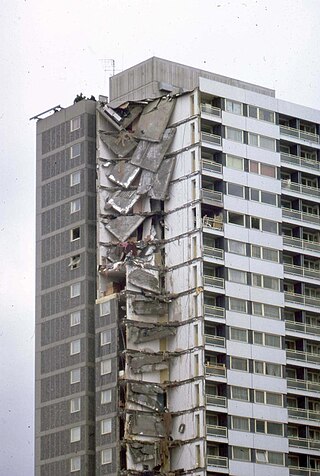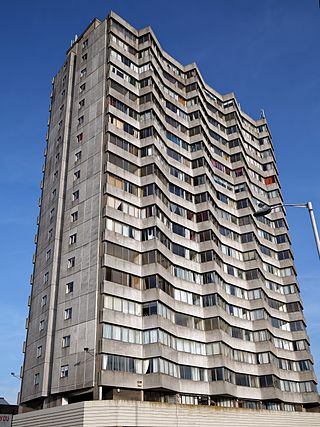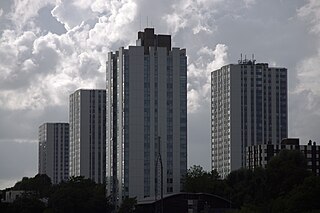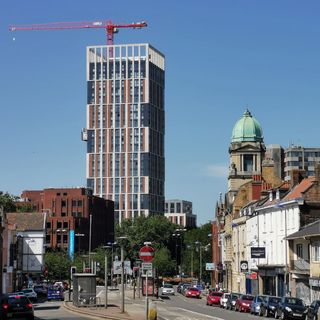Related Research Articles

A tower block, high-rise, apartment tower, residential tower, apartment block, block of flats, or office tower is a tall building, as opposed to a low-rise building and is defined differently in terms of height depending on the jurisdiction. It is used as a residential, office building, or other functions including hotel, retail, or with multiple purposes combined. Residential high-rise buildings are also known in some varieties of English, such as British English, as tower blocks and may be referred to as MDUs, standing for multi-dwelling units. A very tall high-rise building is referred to as a skyscraper.

Ronan Point was a 22-storey tower block in Canning Town in Newham, East London, that partly collapsed on 16 May 1968, only two months after it had opened. A gas explosion blew out some load-bearing walls, causing the collapse of one entire corner of the building; four people died and 17 were injured. The spectacular nature of the failure led to a loss of public confidence in high-rise residential buildings, and major changes in British building regulations resulted.
The Building Act 1984 is a United Kingdom statute consolidating previous legislation concerning the construction process, and the design and specifications for buildings and their component parts, and related matters, in England and Wales. The Welsh Government may make its own Building Regulations under this Act for Wales.
Building regulations in the United Kingdom are statutory instruments or statutory regulations that seek to ensure that the policies set out in the relevant legislation are carried out. Building regulations approval is required for most building work in the UK. Building regulations that apply across England and Wales are set out in the Building Act 1984 while those that apply across Scotland are set out in the Building (Scotland) Act 2003. The Act in England and Wales permits detailed regulations to be made by the Secretary of State. The regulations made under the Act have been periodically updated, rewritten or consolidated, with the latest and current version being the Building Regulations 2010. The UK Government is responsible for the relevant legislation and administration in England, the Welsh Government is the responsible body in Wales, the Scottish Government is responsible for the issue in Scotland, and the Northern Ireland Executive has responsibility within its jurisdiction. There are very similar Building Regulations in the Republic of Ireland.

Somerstown or Somers Town is a residential area of the city of Portsmouth in the English county of Hampshire. The area was one of the most deprived wards in the city, but since 2012, it has been the subject of a major regeneration initiative.

The Building Research Establishment (BRE) is a centre of building science in the United Kingdom, owned by charitable organisation the BRE Trust. It is a former UK government national laboratory that was privatised in 1997. BRE provides research, advice, training, testing, certification and standards for both public and private sector organisations in the UK and abroad. It has its headquarters in Garston, Hertfordshire, England, with regional sites in Glasgow, Swansea, the US, India, the Middle East and China.
The history of fire safety legislation in the United Kingdom formally covers the period from the formation of the United Kingdom of Great Britain and Ireland in 1801 but is founded in the history of such legislation in England and Wales, and Scotland before 1708, and that of the Kingdom of Great Britain from 1707 to 1800.

Sir Kenneth John Knight, is a retired British firefighter and public servant. From 2003 to 2007, he was the Commissioner of the London Fire Brigade and Commissioner for the London Fire and Emergency Planning Authority. From 2007 to 2013, he was the Chief Fire and Rescue Adviser for England.

Kingspan Group plc is a building materials company based in Ireland, trading in over 80 countries with 210+ factories employing over 22,000 people. The company operates with six divisions; Insulated Panels, Insulation, Light & Air, Water & Energy, and, Data & Flooring, Roof & Waterproofing.

Dame Judith Elizabeth Hackitt,, FIChemE, FCGI is a British engineer and civil servant. A former Chair of the UK Health and Safety Executive, she is currently Chair of manufacturing trade body EEF.

Arlington House is an 18-storey residential apartment and commercial block on the seafront of Margate, Kent, England, next to Margate railway station and Dreamland Margate. It was developed by Bernard Sunley and designed by Russel Diplock, and is known for every apartment having a sea view. The building was designed in the style of Brutalist architecture.

On 14 June 2017, a high-rise fire broke out in the 24-storey Grenfell Tower block of flats in North Kensington, West London, at 00:54 BST and burned for 60 hours. 72 people died, two later in hospital, with more than 70 injured and 223 escaping. It was the deadliest structural fire in the United Kingdom since the 1988 Piper Alpha oil-platform disaster and the worst UK residential fire since World War II.

Grenfell Tower is a derelict 24-storey residential tower block in North Kensington in London, England. The tower was completed in 1974 as part of the first phase of the Lancaster West Estate. The tower was named after Grenfell Road, which ran to the south of the building; the road itself was named after Field Marshal Lord Grenfell, a senior British Army officer. Most of the tower was destroyed in a severe fire on 14 June 2017.

The Harrow Court fire occurred in a tower block on 2 February 2005 in Stevenage, Hertfordshire, England. Three people were killed, two of them firefighters, when a fire developed and spread from the 14th floor. An investigation of the fire found that there was an Abnormal Rapid Fire Development, caused by a candle melting the surface of a television, which then spread rapidly up the outside of the building to subsequent floors.

Chalcots Estate is a council housing estate on Adelaide Road and Fellows Road in Swiss Cottage in the London Borough of Camden. It was designed by Dennis Lennon and Partners. The Chalcots Estate was built on land owned by Eton College, which is reflected in the names of the individual buildings.
The Grenfell Tower Inquiry is a British public inquiry into the Grenfell Tower fire, which killed 72 people and destroyed Grenfell Tower on 14 June 2017. It was ordered by Prime Minister Theresa May on the day following the fire.

The United Kingdom cladding crisis, also known as the cladding scandal, is an ongoing social crisis that followed the Grenfell Tower fire of 14 June 2017 and the Bolton Cube fire of 15 November 2019. The fires revealed that large numbers of buildings had been clad in dangerously combustible materials, comprising a combination of flammable cladding and/or flammable insulation.

Criticism of the response to the Grenfell Tower fire primarily consisted of condemnation of issues with the emergency response and fire safety regulation practices in the UK at the time. Broader political criticism was also directed at British society, including condemnation of the response by governmental bodies and UK politicians, social divisions, deregulation issues, and poor transparency overall.

Castle Park View is a 26-storey high-rise in Bristol, England. Completed in 2022, the development occupies the site of the former Central Ambulance Station at the corner of Castle Street and Tower Hill and was proposed in 2017, with work starting in 2019. Designed by Chapman Taylor, the development contains 375 apartments and is the tallest building in Bristol at a height of 98m.
References
- 1 2 "Fact sheet: Secure information box (regulation 4)". GOV.UK. Retrieved 2023-05-08.
- ↑ "Premises Information Boxes - Avon Fire & Rescue Service". www.avonfire.gov.uk. Retrieved 2023-05-08.
- ↑ "Fact sheet: Overview". GOV.UK. Retrieved 2023-05-08.